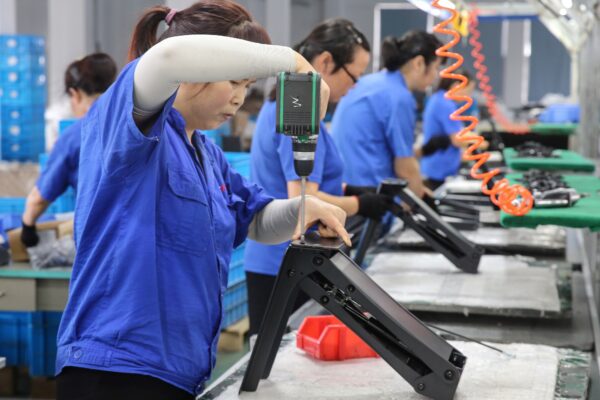News Analysis
More than half of China’s provinces have issued local power restrictions since September. The resulting widespread power outages and cuts under Beijing’s new energy policies will likely fuel global inflation by 0.5 to 1 percent, and drive a price increase of 10 to 15 percent in the United States over the Christmas season on retailed goods imported from China, an economist has said.
Huang Jun, a Chinese economist who now lives in the United States, told The Epoch Times that the power outages in China will cut off one-third of the country’s production capacity. Huang was the former lead columnist for Chinese state-owned broadcaster CNTV and the former chief economist at China Enterprise Capital Union (CECU). He is now director of the Asian Real Estate Association in the United States.
Affected by China’s power outages and cuts, some of the U.S. retail goods could see prices 10 to 15 percent higher, since about 40 percent of products come from China. This price increase is expected in the two months before and after Christmas, Huang added.
The impact of China’s power crunch on the global supply chain, as estimated by Huang following a survey of China-based manufacturers, will mainly reflect on four industries: textiles; toys, stationery, and office supplies; computers and computer accessories; and machinery parts.

According to local reports, in the southern city of Dongguan in China’s Guangdong Province, factories have been receiving official notices, restricting their operations to between 1-3 days per week depending on the scale and priority of the factory’s work as defined by the authorities.
In Zhejiang Province, the authorities are strictly controlling the manufacturing capacity of textile printing and dyeing, and chemical fiber and plastic products in its cities, including Shaoxing, Huzhou, Jiaxing, and Wenzhou.
Meanwhile, the Jiangsu provincial authority issued an emergency notice on Sept. 16, announcing that it was restricting electricity supply from midnight Sept. 15 to Sept. 30. Impacts of the power restrictions have also rippled over to Jiangsu’s semiconductor industry. Some chip packaging service providers, like Intel, Nvidia, and Qualcomm, received notices to shut down their plants for several days. Chang Wah Technology, a semiconductor packaging materials supplier, also announced a one week’s stoppage of work.
Eson Precision Industry, a major mechanical components supplier for Apple, said that its plant in Kunshan, Jiangsu Province, had been suspended Oct. 3 to Oct. 8 due to city policy. Unimicron Technology, a printed circuit board supplier for Apple, also said its factories in Suzhou and Kunshan would stop production from Oct. 3 to the end of the month.
Due to China’s large-scale power crunch, Nomura Securities has diminished its forecast for China’s GDP growth to 4.7 percent in the third quarter and 3.0 percent in the fourth quarter, down from a forecasted 5.1 percent and 4.4 percent respectively, and has cut its full-year forecast from 8.2 percent to 7.7 percent, Reuters reported.
As to the causes of China’s power shortage, Huang pointed to four main factors.
“The first reason lies in the imbalance between power generation and electricity consumption in China: 16.4 percent of Chinese electricity is supplied by hydroelectric power, and the consumption for industrial and residential electricity keeps increasing, while hydropower supply reduces, especially in the winter when many areas enter their dry season for the year.”
For example, in January, Huang said, about 100 billion kilowatt-hours of electricity was generated. “But most of China is still very cold in January, and the demands for heating are maybe 120 billion kilowatt-hours, so electricity sees its shortage of 20 billion kilowatt-hours.”
The second reason, Huang said, is that Chinese manufacturers are still receiving large volumes of international orders, especially in the second half of 2020, which has kept up electricity consumption.
According to Huang, the third reason is linked to a political tug-of-war between the Chinese Communist Party (CCP) and Australia, which resulted in a ban on Australian coal. Therefore, Chinese power plants have had to turn to Indonesia and Russia for their coal imports, but this has caused operational losses for power plants.
“Now instead of burning Australian coal, [the Chinese authorities] have asked [power plants] to burn Indonesian coal and Russian coal. Firstly, its calorific value of power generation is different; secondly, its parameters are different, which will incur mechanical operation problems,” Huang said.
“Of course, the plants can debug it, but it needs stoppages of work. Once the engine stops then start again, it is really a very, very big loss.”
The fourth reason is the CCP’s climate pledges, including that China must shut down 588 coal-fired power plants within 10 years.
China is currently running 1,058 coal plants—more than half the world’s capacity—the BBC reported in April.
“Basically, China must shut down a lot of coal-fired power plants, about half of them, to meet its environmental requirements. But these plants supply more than 35 percent of China’s electricity generation. That means there is a 35 percent energy gap. It is hard to cover even if wind power is increased by seven or eight times,” Huang said.
 RSS Feed
RSS Feed















 October 20th, 2021
October 20th, 2021  Awake Goy
Awake Goy 
 Posted in
Posted in  Tags:
Tags: 













